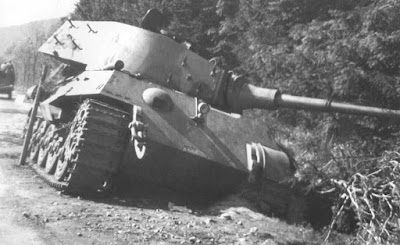One of the last Tiger IIs produced by Henschel during March 1945 and
collected by 3./s.H.Pz.Abt.511.
While medium armored fighting vehicles such as the German
Panther or Soviet T-34 possessed a balanced triad of firepower, mobility, and
protection that permitted them to undertake a variety of combat roles, the
Tiger II's greater weight relegated it to more limited defensive operations.
Its size made movement through urban environments or along narrow roads
difficult, while its drivetrain was under-strength, the double radius L801
steering gear was stressed, and the seals and gaskets were prone to leaks.
Limited crew training could amplify these problems as inexperienced drivers
could inadvertently run the engine at high RPMs or move over terrain that
overly tasked the suspension. Extended travel times under the Tiger II's own
power stressed the swingarms that supported the road wheels and made them
susceptible to bending. Such axial displacement would probably strain the tracks
and bend the link bolts to further disrupt proper movement. Over-worked engines
needed to be replaced roughly every 1,000km. Although wide tracks aided
movement over most terrain, should the vehicle require recovery another Tiger
II was typically needed to extract it. Requirements for spare parts were
understandably high, and maintenance was an ongoing task, all of which reduced
vehicle availability.
The Tiger II's long main armament, the epitome of the family
of 88mm antiaircraft/antitank guns that had terrorized enemy armor since the
Spanish Civil War (1936-39), fired high-velocity rounds along a relatively flat
trajectory. In combination with an excellent gunsight, the weapon system was
accurate at long range, which enabled rapid targeting and a high first
look/first hit/first kill probability. However, the lengthy barrel's overhang
stressed the turret ring, and made traverse difficult when not on level ground.
Optimally initiating combat at distances beyond which an enemy's main armament
could effectively respond, the Tiger II's lethality was further enhanced by its
considerable armor protection, especially across the frontal arc that provided
for a high degree of combat survivability. Although the vehicle's glacis does
not appear to have ever been penetrated during battle, its flanks and rear were
vulnerable to enemy antitank weapons at normal ranges.
In the hands of an experienced crew, and under environmental
and terrain conditions that promoted long-range combat, the weapon system
achieved a high kill ratio against its Allied and Red Army counterparts. 503rd
Heavy SS Panzer Battalion, for example, was estimated to have scored an
estimated 500 "kills" during the unit's operational life from January
to April 1945. While such a figure was certainly inflated as accurate record
keeping was hindered by the unit's dispersed application and chaotic late-war
fighting where the Soviets eventually occupied a battlefield, it illustrated
the success of the weapon system if properly employed and supported. Of 503rd
Heavy SS Panzer Battalion's original complement of 39 Tiger IIs only ten were
destroyed through combat, with the remainder being abandoned or destroyed by
their crews due to mechanical breakdowns or lack of fuel. As 503rd Heavy SS
Panzer Battalion never received replacement tanks like its brethren in 501st
and 502nd Heavy SS Panzer Battalions (which were given 2.38 and 1.7 times their
respective 45-vehicle TO&E allotments), its Tiger II combat losses averaged
less than 50 percent.
Because of the chaotic combat environment throughout
Pomerania, and the need to quickly allocate resources to several threatened
sectors at once, the Tiger IIs were frequently employed singly, or in small
groups, often at the will of a local senior commander. In much the same way as
with the French in 1940, 503rd Heavy SS Panzer Battalion's armor acted more in
an infantry-support capacity than as a unified armored fist. The Tiger IIs
would perhaps have been better used organizationally to fill a Panzer
regiment's heavy company by strengthening existing, depleted parent formations;
but instead they remained in semi-independent heavy Panzer battalions until the
end of the war. Forced to rely on small-unit tactics, Tiger II crews played to
their strengths by adopting ambush tactics to minimize vehicular movement and
pre-combat detection, especially from enemy ground-attack aircraft.
As tankers regularly spent long hours in their mounts the
Tiger II's relatively spacious interior helped reduce fatigue, and made
operating and fighting within the vehicle somewhat less taxing. A good heating
and ventilation system improved operating conditions, which then reduced crew
mistakes that were all too common during a chaotic firefight. Although the
Tiger II had well-positioned ammunition racks that facilitated loading,
projectiles that were stored in the turret bustle were susceptible to
potentially catastrophic damage caused by spalling or projectile impacts. Even
after Henschel incorporated spall liners to reduce such debris, concerned crews
would often leave the turret rear empty, which correspondingly made room to use
the rear hatch as an emergency exit.
The cost to produce the Tiger II in manpower and time
(double that of a 45-tonne Panther), and its high fuel consumption, brought
into question why such a design progressed beyond the drawing board considering
Germany's dwindling resources and military fortunes. It was partly a response
to the perpetual escalation of the requirement to achieve or maintain
battlefield supremacy, and much of the blame rested with Hitler and his desire
for large armored vehicles that in his view presumably reflected Germany's
might and reinforced propaganda. By not focusing resources on creating greater
numbers of the latest proven designs such as the Panther G, German authorities
showed a lack of unified direction and squandered an ability to fight a war of
attrition until it was too late to significantly affect the outcome. Limited
numbers of qualitatively superior Tiger IIs could simply not stem the flood of
enemy armor.







No comments:
Post a Comment